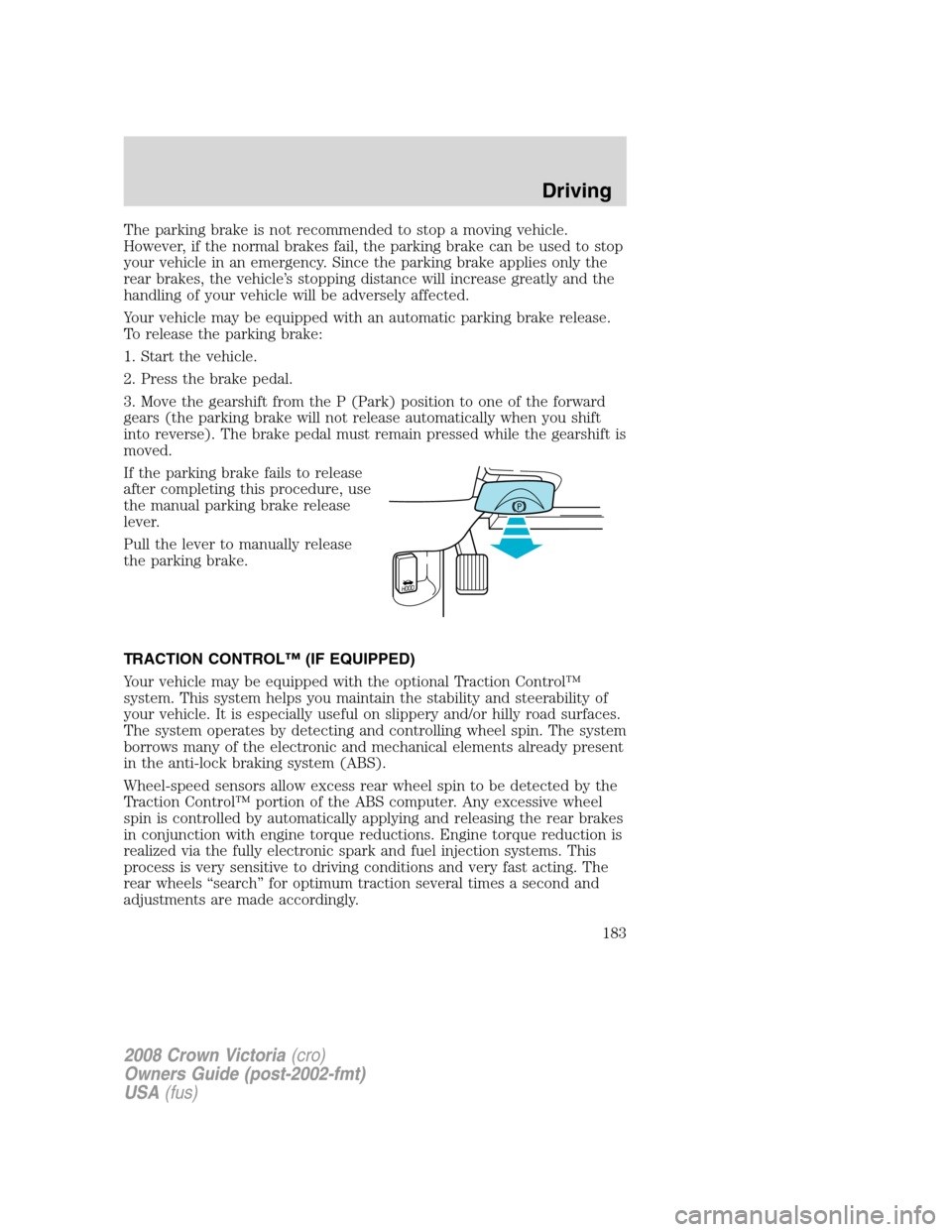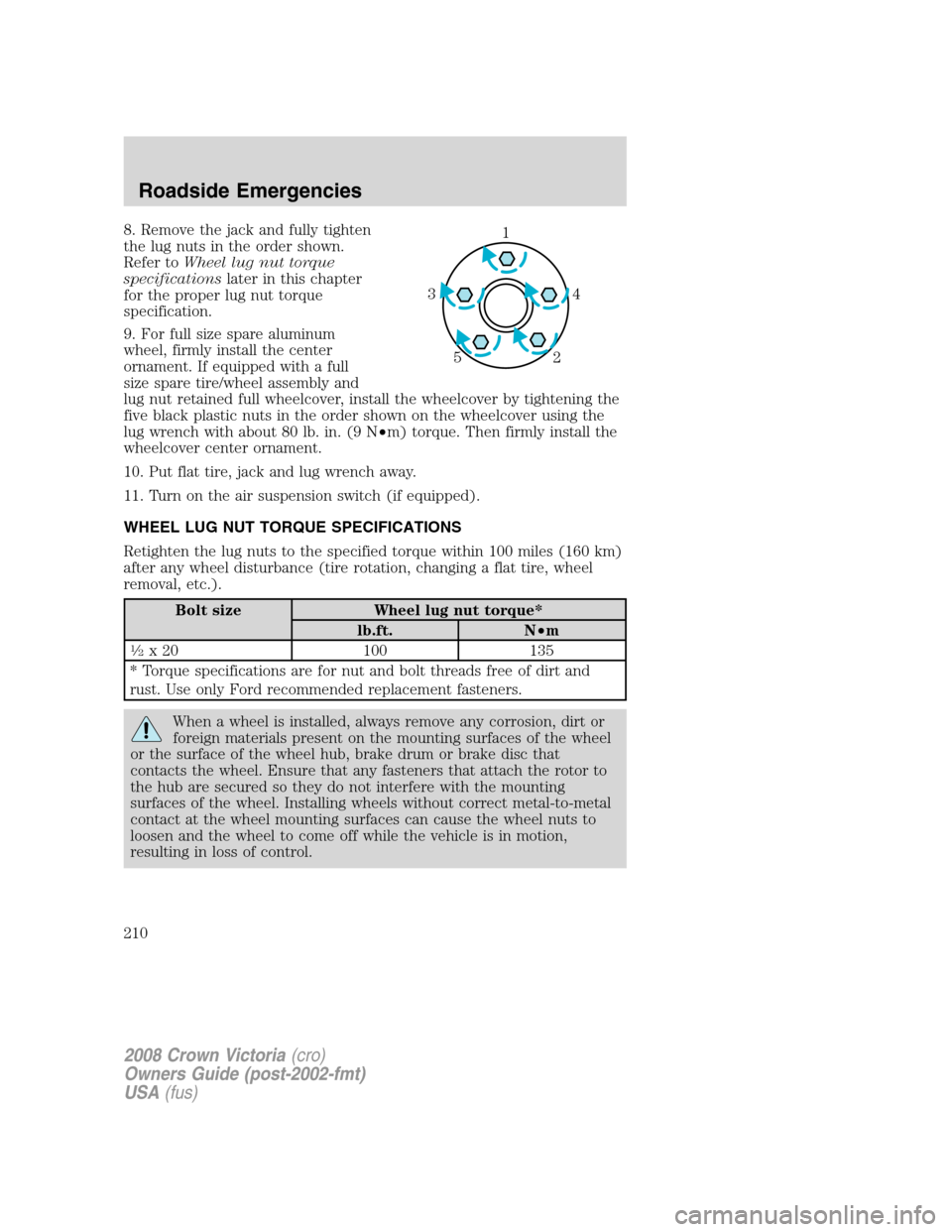torque FORD CROWN VICTORIA 2008 2.G Owners Manual
[x] Cancel search | Manufacturer: FORD, Model Year: 2008, Model line: CROWN VICTORIA, Model: FORD CROWN VICTORIA 2008 2.GPages: 280, PDF Size: 2.42 MB
Page 2 of 280

Seating and Safety Restraints 101
Seating 101
Safety restraints 106
Airbags 121
Child restraints 133
Tires, Wheels and Loading 145
Tire information 145
Tire inflation 147
Tire Pressure Monitoring System (TPMS) 160
Vehicle loading 165
Trailer towing 171
Recreational towing 174
Driving 175
Starting 175
Brakes 180
Traction Control™ 183
Air suspension 186
Transmission operation 187
Roadside Emergencies 192
Getting roadside assistance 192
Hazard flasher switch 193
Fuel pump shut-off switch 194
Fuses and relays 195
Changing tires 203
Lug nut torque 210
Jump starting 211
Wrecker towing 216
Customer Assistance 217
Reporting safety defects (U.S. only) 223
Reporting safety defects (Canada only) 224
Cleaning 225
Table of Contents
2
2008 Crown Victoria(cro)
Owners Guide (post-2002-fmt)
USA(fus)
Page 183 of 280

The parking brake is not recommended to stop a moving vehicle.
However, if the normal brakes fail, the parking brake can be used to stop
your vehicle in an emergency. Since the parking brake applies only the
rear brakes, the vehicle’s stopping distance will increase greatly and the
handling of your vehicle will be adversely affected.
Your vehicle may be equipped with an automatic parking brake release.
To release the parking brake:
1. Start the vehicle.
2. Press the brake pedal.
3. Move the gearshift from the P (Park) position to one of the forward
gears (the parking brake will not release automatically when you shift
into reverse). The brake pedal must remain pressed while the gearshift is
moved.
If the parking brake fails to release
after completing this procedure, use
the manual parking brake release
lever.
Pull the lever to manually release
the parking brake.
TRACTION CONTROL™ (IF EQUIPPED)
Your vehicle may be equipped with the optional Traction Control™
system. This system helps you maintain the stability and steerability of
your vehicle. It is especially useful on slippery and/or hilly road surfaces.
The system operates by detecting and controlling wheel spin. The system
borrows many of the electronic and mechanical elements already present
in the anti-lock braking system (ABS).
Wheel-speed sensors allow excess rear wheel spin to be detected by the
Traction Control™ portion of the ABS computer. Any excessive wheel
spin is controlled by automatically applying and releasing the rear brakes
in conjunction with engine torque reductions. Engine torque reduction is
realized via the fully electronic spark and fuel injection systems. This
process is very sensitive to driving conditions and very fast acting. The
rear wheels “search” for optimum traction several times a second and
adjustments are made accordingly.
2008 Crown Victoria(cro)
Owners Guide (post-2002-fmt)
USA(fus)
Driving
183
Page 210 of 280

8. Remove the jack and fully tighten
the lug nuts in the order shown.
Refer toWheel lug nut torque
specificationslater in this chapter
for the proper lug nut torque
specification.
9. For full size spare aluminum
wheel, firmly install the center
ornament. If equipped with a full
size spare tire/wheel assembly and
lug nut retained full wheelcover, install the wheelcover by tightening the
five black plastic nuts in the order shown on the wheelcover using the
lug wrench with about 80 lb. in. (9 N•m) torque. Then firmly install the
wheelcover center ornament.
10. Put flat tire, jack and lug wrench away.
11. Turn on the air suspension switch (if equipped).
WHEEL LUG NUT TORQUE SPECIFICATIONS
Retighten the lug nuts to the specified torque within 100 miles (160 km)
after any wheel disturbance (tire rotation, changing a flat tire, wheel
removal, etc.).
Bolt size Wheel lug nut torque*
lb.ft. N•m
1�2x 20 100 135
* Torque specifications are for nut and bolt threads free of dirt and
rust. Use only Ford recommended replacement fasteners.
When a wheel is installed, always remove any corrosion, dirt or
foreign materials present on the mounting surfaces of the wheel
or the surface of the wheel hub, brake drum or brake disc that
contacts the wheel. Ensure that any fasteners that attach the rotor to
the hub are secured so they do not interfere with the mounting
surfaces of the wheel. Installing wheels without correct metal-to-metal
contact at the wheel mounting surfaces can cause the wheel nuts to
loosen and the wheel to come off while the vehicle is in motion,
resulting in loss of control.
1
4 3
2 5
2008 Crown Victoria(cro)
Owners Guide (post-2002-fmt)
USA(fus)
Roadside Emergencies
210